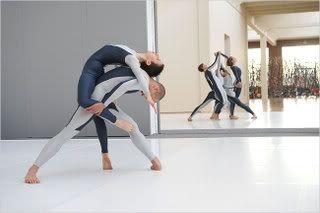
Pullman's His Subtle Knife:
Choreographed by Merce Cunningham;
Danced by the Cunningham Company
Choreographed by Merce Cunningham;
Danced by the Cunningham Company
Alternate Worlds Moving on Two Stages,
Performing for One Audience
I've been attending the revelatory Merce Cunningham 'events' all my adult life -- on occasion the spouse has been honored as a composer for an edition of these events, so famous, for so long, in the world of art and dance. These were informal gatherings of audience and company in the Cunningham studio, devised for choreographer, dancers, composer and audience to exchange energies via the matrix of Cunningham at play, with his constant playmates, time and space.
This weekend the Cunningham Company held an 'event' at the glorious Dia Art Foundation - museum, which is located outside of Beacon, NY. I can personally testify that the land upon which the the arts' container, a work of architectual art itself, is sited, provides a canvas of seasonal light and shadow display that is breathtaking, no matter the weather or the time of year. This weekend's event at Dia included choreography inspired by Pullman's The Subtle Knife. The NY Times dance critic describes the event thus:
[ To watch his company on Saturday afternoon in the first of two Cunningham Events last weekend at Dia:Beacon was to see a poetically compelling exposition of parallel-universe theory. Before at Dia:Beacon, Mr. Cunningham has staged events on two or more stages at the same time. In 2004, working on three stages at the Tate Modern in London, he employed a barrier that prevented audiences from seeing all three at once unless they looked up to the lofty mirrored ceiling in Turbine Hall (where the full action was visible, though very distant).
On Saturday at Dia:Beacon he placed his two stages adjacent but on either side of a square doorway. Wherever you were sitting, you could see only part, never all, of the stage on the opposite side. That door, leading from one world to a parallel stage, evoked the controlling image of The Subtle Knife, the second novel of Philip Pullman's trilogy His Dark Materials. In it the young hero can cut his way, slicing a square aperture in the air, from this Oxford into different worlds, at least one of which contains an alternative Oxford.
As the event began, the stage farthest from me looked breathtakingly like a mirror of the one closer to me. One group of dancers was moving in slow, controlled adagio, stepping, arching and bending with precision, while another, dressed identically, was doing the same but facing the other way.
Then, more than a minute into the dance, the denizens of the through-the-looking-glass world started to move in other steps and in a different tempo, whereupon the dichotomy between these two now dissimilar stages became both frustrating and entrancing. Here the dancers were balancing, fixed, waiting; there they were leaping fast across the space, caught up in some rush of which we could see only a fraction. And, like characters in the Pullman novels, dancers moved from one world, or stage, to another and back again. ]
Watching a Cunningham choreography, whether from early in his career (he's now 91), or one just recently created, one feels she has left this world and re-entered another that has been lost, a world in which the sacred exists, as both sublime and far beyond any rigid and short-sighted religion, to a world that has existed long before this one, and which will survive hard and passionate once we have departed. It's a privilege that everyone should be entitled to experience.
So it's natural that this man would be drawn to a book by a YA author that speaks to slicing open gates that allow him, his dancers and us, to enter parallel worlds.

1 comment:
Nothing in dance is as complicated to dance, as Merce Cunningham's choreography. That includes ballet.
Most choreography flows with natural movement, ebb and flows, gravity and direction. Cunningham takes away a dancer's safety net. He goes against how the dancer wants to move.
I think Cunningham's choreography, is like Rochmaninoff is to the piano. The highest level.
Post a Comment